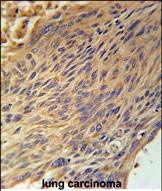


| WB | 1/1000 | Human,Mouse,Rat |
| IF | 咨询技术 | Human,Mouse,Rat |
| IHC | 1/100-1/500 | Human,Mouse,Rat |
| ICC | 技术咨询 | Human,Mouse,Rat |
| FCM | 咨询技术 | Human,Mouse,Rat |
| Elisa | 咨询技术 | Human,Mouse,Rat |
| Aliases | Cytoplasmic polyadenylation element-binding protein 4, CPE-BP4, CPE-binding protein 4, hCPEB-4, CPEB4, KIAA1673 |
| Entrez GeneID | 80315 |
| WB Predicted band size | 80.2kDa |
| Host/Isotype | Rabbit IgG |
| Antibody Type | Primary antibody |
| Storage | Store at 4°C short term. Aliquot and store at -20°C long term. Avoid freeze/thaw cycles. |
| Species Reactivity | Human, Mouse |
| Immunogen | This CPEB4 antibody is generated from rabbits immunized with a KLH conjugated synthetic peptide between 109-137 amino acids from the N-terminal region of human CPEB4. |
| Formulation | Purified antibody in PBS with 0.05% sodium azide. |
+ +
以下是3篇涉及CPEB4(N-term)抗体的参考文献概览:
1. **文献名称**: *CPEB4 links the clock and the UPR to eradicating tumors*
**作者**: Kroschwald, S. et al.
**摘要**: 该研究揭示了CPEB4在肿瘤细胞节律性调控中的作用,利用N端特异性抗体进行免疫印迹分析,发现CPEB4通过结合内质网应激相关mRNA,协调生物钟与未折叠蛋白反应(UPR),影响肿瘤细胞的生存与治疗抵抗。
2. **文献名称**: *CPEB4 regulates cancer stemness and drug resistance via translational control of TGFβ signaling*
**作者**: Pérez-Guijarro, E. et al.
**摘要**: 研究通过CPEB4 N端抗体的免疫沉淀实验,证明CPEB4通过选择性翻译TGFβ通路基因(如SMAD2/4)维持肿瘤干细胞特性。敲低CPEB4可增强化疗敏感性,提示其作为治疗靶点的潜力。
3. **文献名称**: *Isoform-specific roles of CPEB4 in glioblastoma progression and metabolic adaptation*
**作者**: Doldán, A. et al.
**摘要**: 利用N端抗体区分CPEB4不同异构体,发现长异构体(CPEB4-L)在胶质母细胞瘤中高表达,通过调控线粒体代谢相关mRNA的翻译促进肿瘤侵袭。研究强调了抗体在解析异构体功能中的关键作用。
**提示**:如需获取具体文献,建议在PubMed或Web of Science中搜索上述标题及作者,或通过抗体供应商(如Abcam、Sigma-Aldrich)的产品引用列表查找相关研究。
The CPEB4 (N-term) antibody is a tool used to detect the N-terminal region of the Cytoplasmic Polyadenylation Element-Binding Protein 4 (CPEB4), a member of the CPEB family of RNA-binding proteins. CPEB proteins regulate mRNA translation by binding to cytoplasmic polyadenylation elements (CPEs) in the 3' untranslated regions (UTRs) of target mRNAs, influencing polyadenylation and translational activation or repression. CPEB4. in particular, plays roles in cellular stress responses, tumor progression, angiogenesis, and neurodegenerative diseases. It is overexpressed in certain cancers, where it promotes tumorigenesis by enhancing the translation of pro-survival and metastatic mRNAs.
The N-terminal-specific antibody allows researchers to distinguish CPEB4 from other family members (e.g., CPEB1-3) and study its expression, localization, and function. It is commonly used in techniques like Western blotting, immunohistochemistry, and immunofluorescence to investigate CPEB4’s involvement in pathological and physiological processes. Studies using this antibody have highlighted its nuclear-cytoplasmic shuttling behavior and association with stress granules under cellular stress. Validation typically includes knockout controls or siRNA-mediated knockdown to confirm specificity. Its development has advanced understanding of post-transcriptional regulation in diseases, particularly cancer and neurological disorders, making it a critical reagent in molecular and clinical research.
×